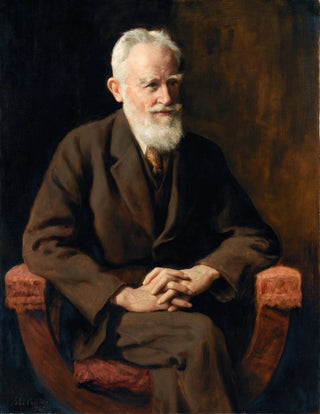Art print | Portrait of George Bernard Shaw 1856-1950 Playwright - John Collier


View from behind

Frame (optional)
In the fascinating world of art, some works stand out for their ability to capture not only an image but also the very essence of an individual. The "Art print of George Bernard Shaw 1856-1950 Playwright" by John Collier is a perfect example. This iconic piece, which immortalizes one of the most influential playwrights of the 20th century, invites us to delve into the intellectual and artistic universe of his era. By contemplating this portrait, the viewer is transported into a silent dialogue with the artist, discovering the subtleties of Shaw's personality, his sharp wit, and his social engagement. This painting does not merely depict a man; it evokes a moment in history when words and ideas had the power to transform societies.
Style and uniqueness of the work
John Collier's style is characterized by an exceptional mastery of details and a color palette that evokes an atmosphere both intimate and solemn. In the portrait of Shaw, Collier uses shades of brown and green to create a warm ambiance that highlights the expressive face of the playwright. The play of light and shadow accentuates Shaw's features, revealing his complex personality. Every brushstroke seems to tell a story, and one can almost hear the lines from his plays resonating in the air. This painting, while a tribute to the man, is also a reflection on the power of art and literature. The way Collier manages to capture Shaw's lively intellect demonstrates a rare artistic sensitivity, making this work a true masterpiece.
The artist and his influence
John Collier, an emblematic figure of British painting, knew how to carve out a prominent place in the artistic landscape of the early 20th century. Influenced by the artistic movements of his time, Collier developed a style that combines realism and symbolism, creating portraits of rare emotional depth. His work with renowned personalities, such as George Bernard Shaw, testifies to his ability to grasp the essence of his subjects. Collier does not limit himself to painting faces; he seeks to reveal the stories

Matte finish

View from behind

Frame (optional)
In the fascinating world of art, some works stand out for their ability to capture not only an image but also the very essence of an individual. The "Art print of George Bernard Shaw 1856-1950 Playwright" by John Collier is a perfect example. This iconic piece, which immortalizes one of the most influential playwrights of the 20th century, invites us to delve into the intellectual and artistic universe of his era. By contemplating this portrait, the viewer is transported into a silent dialogue with the artist, discovering the subtleties of Shaw's personality, his sharp wit, and his social engagement. This painting does not merely depict a man; it evokes a moment in history when words and ideas had the power to transform societies.
Style and uniqueness of the work
John Collier's style is characterized by an exceptional mastery of details and a color palette that evokes an atmosphere both intimate and solemn. In the portrait of Shaw, Collier uses shades of brown and green to create a warm ambiance that highlights the expressive face of the playwright. The play of light and shadow accentuates Shaw's features, revealing his complex personality. Every brushstroke seems to tell a story, and one can almost hear the lines from his plays resonating in the air. This painting, while a tribute to the man, is also a reflection on the power of art and literature. The way Collier manages to capture Shaw's lively intellect demonstrates a rare artistic sensitivity, making this work a true masterpiece.
The artist and his influence
John Collier, an emblematic figure of British painting, knew how to carve out a prominent place in the artistic landscape of the early 20th century. Influenced by the artistic movements of his time, Collier developed a style that combines realism and symbolism, creating portraits of rare emotional depth. His work with renowned personalities, such as George Bernard Shaw, testifies to his ability to grasp the essence of his subjects. Collier does not limit himself to painting faces; he seeks to reveal the stories






